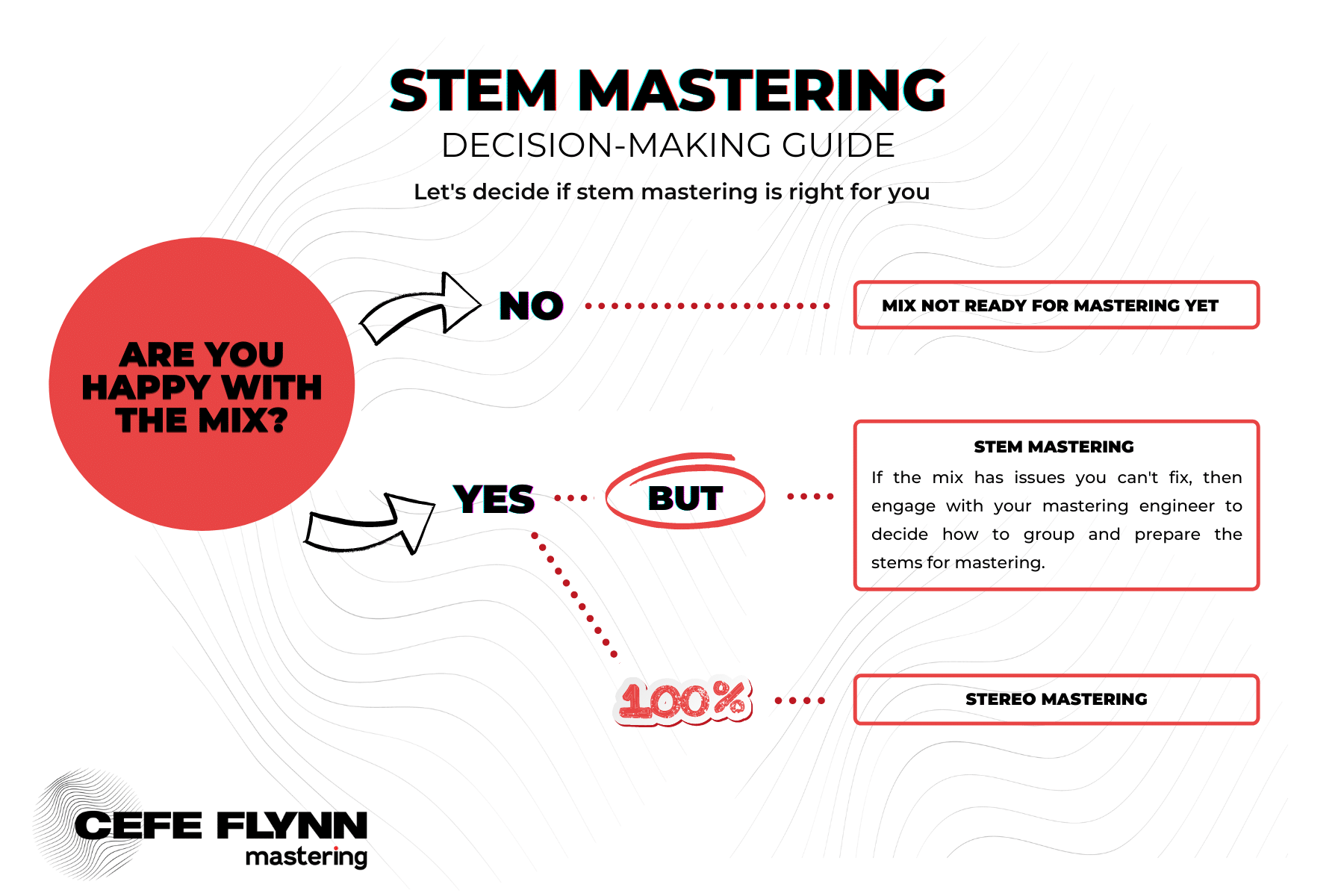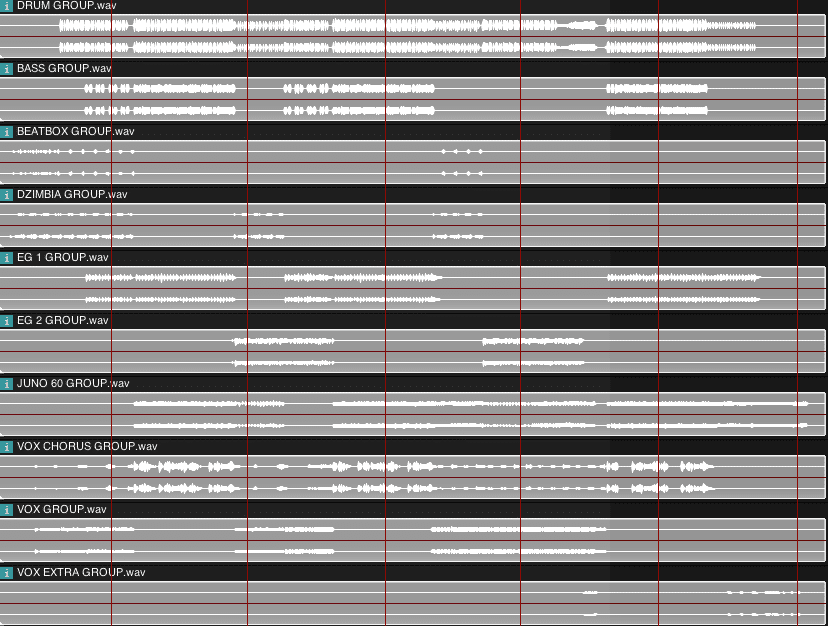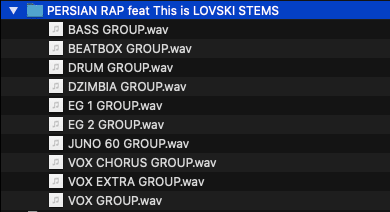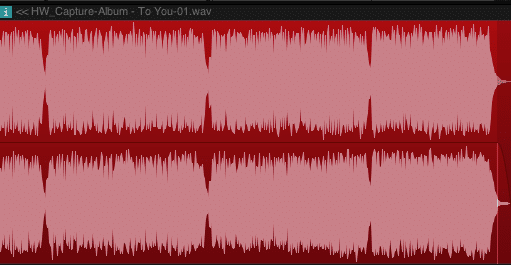Stem mastering has become an increasingly common alternative to stereo mastering, as more and more artists record their tracks at home. Though it has some benefits such as giving the artist more control, there are many circumstances where you might not actually need it.
Read on to learn more about stem mastering and decide if it’s right for you.
What is stem mastering?
Stem mastering is the process of mastering a song using a group of stereo stems i.e. groups of similar-sounding instruments. On the other hand, traditional stereo mastering uses only one stereo audio file as its source for mastering. Though they are different techniques, both mastering approaches have the same end goal: to enhance the song and prepare it for distribution.
Stem mastering should not be confused with mixing multi tracks. Here is an article with more information about the difference between mixing and mastering for reference. A mixing session should be performed beforehand by the mixing engineer or producer who will then export the stems according to what the mastering engineer has requested. The number of stems requested can vary depending on what the mastering engineer considers will give the best results for the project.
Stem mastering sessions typically include somewhere between two to eight stems.
A simple session generally found in Hip Hop tracks will include a lead rap stem, backing vocals, ad libs and the beat (instrumental).
Sometimes if you want more control over the sound, you can split the music into smaller elements. A typical example will be a kick stem, snare stem, bass stem, vocal stem and rest of instrumentation stem.
A key aspect of stem mastering is that the stems should include all the effects and processing used during mixing, for example, EQ, compression, and time-based effects like reverb or delay.
Let’s assume you have recorded five different guitars/takes. So, when you’re mixing, you will have five guitar tracks that you will EQ, compress and add reverb and delays etc. to make those tracks fit in the overall mix. Then, when you are preparing for stem mastering, you’ll combine those five tracks and export them as a stereo track, including the effects, volume automation and panning you have on them during mixing.
When to use it?
Stem mastering is generally used when there is an issue in the mix. This could be due to a mixing engineer’s lack of experience or working under less than ideal monitoring conditions during the mix session.
For example, if you think the mix is 90% there, but can’t quite get the right low-end balance compared to current releases in the genre, then this approach would be a great option to address that issue.
You would send to the mastering engineer the stems for the kick, bass, snare, vocal, and the rest of the instrumentation (music) which would allow the mastering engineer to adjust the relationship between the kick and bass channels without affecting the low-end of every other track in the mix.
Since the mixing engineer already worked on each track, the mastering engineer’s job is not to polish or embellish each track but generate an optimal-sounding master overall for final distribution.
However, if there is no issue with the mix and you are 100% happy with how it sounds, then traditional stereo mastering would be the best option for the project. On the other hand, if you are not happy with the mix, then that would be an indication your mix is not ready for mastering yet.
See the below chart to quickly assess what mastering approach would work best for your track.

How does it work?
Preparing for stem mastering
When mastering from stems, you will have multiple stereo tracks. As a general rule, you want to group similar instruments together. An example set of stems would be 1. Kick drum, 2. Other drums and percussion and, 3. Bass guitar, 4. Synths and keys, 5. Guitars, 6. Lead vocals, 7. Backing vocals.
While preparing and exporting the stems, only the processing on the master channel should be bypassed.
All the stems should have the same length, and start and stop at the same time in the timeline (this is crucial, so the tracks line up when they’re imported and combined together). Ideally, when the stems are imported back into the DAW for the stem mastering session, this should sound pretty much identical to the mix.

How to export stems
Here is a brief description of how to prepare and export stems ready for mastering. The mixing engineer or producer can use different methods to create stems. Here I describe creating stems using multiple passes in Solo. A step by step approach would look something like this:
- First, bypass all the effects on the master channel.
- Next, solo the relevant groups of tracks and bounce them out one stem at a time. For example, to create a “guitars stems”, solo all the guitar tracks in the mix.
- Make a selection from the start to the end of the session, and bounce the file. Repeat this process for all the stems.
- Label each stem accordingly. (Examples: Kick Drum, Bass, Other Drums, Synth and Keys, Vocal, Background Vocals etc.)
- When creating the stems, the preferred file format is a 24-bit WAV file.
- After all stems are exported, create a new DAW session and import the stems. The mix should still sound very close to the original mix. Double-check nothing is missing in the mix.
- Create a new folder, add all the stems, and create a ZIP file to send to your mastering engineer. It’s also recommended to include a bounce of the original mix as a reference.

Stem mastering process: What does the engineer do?
Once the stems have been imported back into the digital audio workstation for the mastering session, the first thing I check is that it still sounds very close to the original mix. For this, I would always request a reference mix together with the stems.
After we are sure the stems are good to go, I would generally then route through my master channel and analog equipment and listen to it as if I was working out of a stereo file. Next, I’ll start mastering the song as a whole through the master channel and analogue chain and address each stem where necessary. I’ll use equalisation, compression, saturation, etc. as needed to make the most out of the song.
Once I’m happy with the result, I will capture a stereo file from the analogue chain into my digital audio workstation. Just like stereo mastering, this will be the final stereo file ready for distribution.

Stem mastering prices
Stem mastering prices, just as stereo mastering, vary depending on the mastering engineer taking on the job. However, as a general rule, stem mastering is always more expensive than stereo mastering. The main reason behind this is that the overall process takes longer, from file management to setting up the sessions, editing and processing the individual stems, etc, leading to additional time and compensation needed for the process.
Most of the time, stem mastering will have a base cost of up to a certain amount of stems. For example, in my case, the price is calculated as per the below.
- Stereo Mastering: 1 stereo file = $100 AUD
- Stem Mastering: 2 Stems = $120 AUD
- Stem Mastering: 3-6 Stems = $180 AUD
- Stem Mastering: over six stems = Add $20 per extra stem on top of the base cost of $180 AUD. E.g. for eight stems, the total cost will be $220 AUD.
Stem mastering services: Where can you get it?
Currently, only mastering studios can offer stem mastering services. AI Online Automated mastering services do not offer stem mastering.
However, not all mastering engineers offer stem mastering as part of their services. Some mastering engineers love working with stems but others feel that stem mastering is almost like mixing. They do not feel comfortable altering the overall mix balance. You will need to talk to a mastering engineer if they are willing to take on a stem mastering project.
In my case, I don’t promote stem mastering on my website as I generally start by providing feedback to the mixer to nail the final mix first. However, if I see that the mix is still missing the mark after the feedback, which could be due to the monitoring environment of the mixer, then I would suggest stem mastering.
On the other hand, if I’m approached by an artist or mixing engineer requesting stem mastering, I’ll certainly engage in a conversation to assess the best mastering approach for the track.
I do quite a bit of stem mastering, but there must be a good reason why we need to take this route instead of traditional stereo mastering.
Summary: What you need to know
Not every mix will need stem mastering. Therefore, there must be a very good reason why you’d decide to go this time consuming, longer turnaround times and more expensive option.
It’s important to understand that stem mastering won’t make up for a bad mix. Stem mastering is not mixing and should not be confused. Stem mastering will work great if you are happy with the mix, but if you are just missing the mark on some aspects, for example, in the low-end balance between bass and kick drum due to poor monitoring systems. In this case, stem mastering will work great as it will allow the mastering engineer to fine-tune the low-end with greater detail.
Before deciding which type of mastering you’d like to choose for your mix, it’s always best to communicate with your mastering engineer and establish the goals to find the right solution for your track. In some cases, stem mastering can work wonders, but in the vast majority of the cases, traditional stereo mastering will be all we need.
